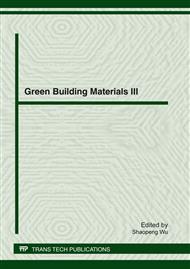[1]
K. Abe, Y. Sanada, T. Morimoto, Anti-Reflective Coatings for CRTs by Sol-Gel Process, J. Sol-Gel Sci. Tech. 22 (2001) 151-166.
DOI: 10.1023/a:1011284824681
Google Scholar
[2]
D.G. Chen, Y.A. Yan, E. Westenberg, et al. Development of Anti-Reflective (AR) Coating on Plastic Panels for Display Applications, J. Sol-Gel Sci. Tech. 19 (2000) 77-82.
Google Scholar
[3]
C. Ballif, J. Dicker, D. Borchert, et al. Solar glass with industry porous SiO2 antireflective coating: measurements of photovoltaic module properties improvement and modelling of yearly energy yield gain, Sol. Energy Mater. Sol. Cells 82 (2004).
DOI: 10.1016/j.solmat.2003.12.004
Google Scholar
[4]
R. Prado, G. Beobide, A. Marcaide, et al. Development of multifunctional sol-gel coatings: Antireflection coatings with enhanced self-cleaning capacity, Sol. Energy Mater. Sol. Cells 94 (2010) 1081-1088.
DOI: 10.1016/j.solmat.2010.02.031
Google Scholar
[5]
A. Chabas, T. Lombardo, H. Cachier, et al. Behaviour of self-cleaning glass in urban atmosphere, Build. Environ. 43 (2008) 2124-2131.
DOI: 10.1016/j.buildenv.2007.12.008
Google Scholar
[6]
Y.J. Song, M.R. Park, E. Guliants, et al. Influence of defects and band offsets on carrier transport mechanisms in amorphous silicon/crystalline silicon heterojunction solar cells, Sol. Energy Mater. Sol. Cells 64 (2000) 225-240.
DOI: 10.1016/s0927-0248(00)00222-1
Google Scholar
[7]
T. Minemoto, T. Mizuta, H. Takakura, et al. Antireflective coating fabricated by chemical deposition of ZnO for spherical Si solar cells, Sol. Energy Mater. Sol. Cells 91 (2007) 191-194.
DOI: 10.1016/j.solmat.2006.08.005
Google Scholar
[8]
P. Nostell, A. Roos, B. Karlsson, Optical and mechanical properties of sol-gel antireflective films for solar energy applications, Thin Solid Film 351 (1999) 170-175.
DOI: 10.1016/s0040-6090(99)00257-6
Google Scholar
[9]
G.M. Wu, J. Wang, J. Shen, et al. A novel route to control refractive index of sol-gel derived nano-porous silica films used as broadband antireflective coatings, Mater. Sci. Eng. B 78 (2000) 135-139.
DOI: 10.1016/s0921-5107(00)00529-8
Google Scholar
[10]
I.M. Thomas, Method for the preparation of porous silica antireflection coatings varying in refractive index from 1. 22 to 1. 44, Appl. Optics 31 (1992) 6145-6149.
DOI: 10.1364/ao.31.006145
Google Scholar
[11]
A. Vincent, S. Babu, E. Brinley, et al. Role of Catalyst on Refractive Index Tenability of Porous Silica Antireflective Coating by Sol-Gel Technique, J. Phys. Chem. C 111 (2007) 8291-8298.
DOI: 10.1021/jp0700736
Google Scholar
[12]
K. Koc, F.Z. Tepehan, G.G. Tepehan, Antirelective coating from Ta2O5 and SiO2 multiplayer films, J. Mater. Sci. 40 (2005) 1363-1366.
DOI: 10.1007/s10853-005-0566-2
Google Scholar
[13]
H.J. Lee, S.H. Hahn, E.J. Kim, et al. Influence of calcination temperature on structural and optical properties of TiO2-SiO2 thin films prepared by sol-gel dip coating, J. Mater. Sci. 39 (2004) 3683-3688.
DOI: 10.1023/b:jmsc.0000030721.88503.c1
Google Scholar
[14]
G.M. Wu, J. Wang, J. Shen, et al. Properties of sol-gel derived scratch-resistant nano-porous silica films by a mixed atmosphere treatment, J. Non-Cryst. Solids 275 (2000) 169-174.
DOI: 10.1016/s0022-3093(00)00257-x
Google Scholar
[15]
A. Taguchi, F. Schuth, Ordered mesoporous materials in catalysis, Micropor. Mesopor. Mater. 77(2005) 1-45.
Google Scholar
[16]
T. Yamada, H.S. Zhou, H. Uchida, et al. Application of a cubic-like mesoporous silica film to a surface photovoltage gassensing system, Micropor. Mesopor. Mater. 54 (2002) 269-276.
DOI: 10.1016/s1387-1811(02)00387-6
Google Scholar
[17]
U. Ciesla, F. Schuth, Ordered mesoporous materials, Micropor. Mesopor. Mater. 27 (1999) 131-149.
Google Scholar
[18]
K.J. Chao, P.H. Liu, K.Y. Huang, Thin films of mesoporous silica: characterization and applications, C. R. Chim. 8 (2005) 727-739.
Google Scholar
[19]
C.M. Yang, A.T. Cho, F.M. Pan, et al. Spin-on Mesoporous Silica Films with Ultralow Dielectric Constants, Ordered Pore Structures, and Hydrophobic Surfaces, Adv. Mater. 13 (2001) 1099-1102.
DOI: 10.1002/1521-4095(200107)13:14<1099::aid-adma1099>3.0.co;2-0
Google Scholar
[20]
S. Seraji, Y. Wu, M. Forbess, et al. Sol-Gel-Derived Mesoporous Silica Films with Low Dielectric Constants, Adv. Mater. 12 (2000) 1695-1698.
DOI: 10.1002/1521-4095(200011)12:22<1695::aid-adma1695>3.0.co;2-v
Google Scholar
[21]
J. Shen, A.Y. Luo, L.F. Yao, et al. Low dielectric constant silica films with ordered nanoporous structure, Mater. Sci. & Eng. C 27 (2007) 1145-1148.
DOI: 10.1016/j.msec.2006.06.037
Google Scholar
[22]
T.J. Ha, S.G. Choi, S.B. Jung, et al. The improvement of mechanical and dielectric properties of ordered mesoporous silica film using TEOS-MTES mixed silica precursor, Ceram. Int. 34(2008) 947-951.
DOI: 10.1016/j.ceramint.2007.09.070
Google Scholar
[23]
X.Y. Li, X. Du, J.H. He, Self-Cleaning Antireflective Coatings Assembled from Peculiar Mesoporous Silica Nanoparticles, Langmuir 26 (2010) 13528-13534.
DOI: 10.1021/la1016824
Google Scholar
[24]
H. Yasuto, Y. Hiroki, N. Atsuro, et al. Mesoporous Silica Nanoparticles with Remarkable Stability and Dispersibility for Antireflective Coatings, Chem. Mater. 22 (2010) 12-24.
Google Scholar
[25]
C.J. Brinker, Y.F. Lu, A. Sellinger A, et al. Evaporation-Induced Self-Assembly: Nanostructures Made Easy, Adv. Mater. 11 (1999) 579-585.
DOI: 10.1002/(sici)1521-4095(199905)11:7<579::aid-adma579>3.0.co;2-r
Google Scholar
[26]
C.T. Kresge, M.E. Leonowicz, W.J. Roth, et al. Ordered mesoporous molecular sieves synthesized by a liquid-crystal template mechanism, Nature 359 (1992) 710-712.
DOI: 10.1038/359710a0
Google Scholar
[27]
E.K. Richman, C.B. Kang, T. Brezesinski, et al. Ordered Mesoporous Silicon through Magnesium Reduction of Polymer Templated Silica Thin Films, Nano Letter 8 (2008) 3075-3079.
DOI: 10.1021/nl801759x
Google Scholar
[28]
X. Zhang, W. Wu, J.F. Wang, et al. Direct synthesis and characterization of highly ordered functional mesoporous silica thin films with high amino-groups content, Appl. Sur. Sci. 254 (2008) 2893-2899.
DOI: 10.1016/j.apsusc.2007.10.022
Google Scholar
[29]
Y.Q. Xiao, J. Shen, Z.Y. Xie, et al. Microstructure Control of Nanoporous Silica Thin Film Prepared by Sol-gel Process, J. Mater. Sci. Tech. 23 (2007) 504-508.
Google Scholar
[30]
G.M. Wu, J. Shen, T.H. Yang, et al. Preparation of Scratch-Resistant Nano-Porous Silica Films Derived by Sol-Gel Process and Their Anti-reflective Properties, J. Mater. Sci. Tech. 19 (2003) 299-302.
Google Scholar
[31]
X.D. Wang, J. Shen, Sol-gel derived durable antireflective coating for solar glass, J. Sol-Gel Sci. Tech. 53 (2010) 322-327.
DOI: 10.1007/s10971-009-2095-y
Google Scholar
[32]
J. Shen, Z.Y. Xie ZY, X.X. Wu, et al. Sol-Gel Derived SiO2 Antireflective (AR) Coating Used in Solar Cells, Rare Metal Mater. Eng. 37 (2008) 47-50.
Google Scholar


